Estrone
Synonym(s):1,3,5(10)-Estratrien-3-ol-17-one;3-Hydroxy-1,3,5(10)-estratrien-17-one;Estrone;Folliculin
- CAS NO.:53-16-7
- Empirical Formula: C18H22O2
- Molecular Weight: 270.37
- MDL number: MFCD00003620
- EINECS: 200-164-5
- SAFETY DATA SHEET (SDS)
- Update Date: 2025-12-25 11:31:46
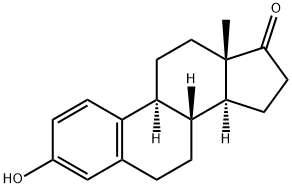
What is Estrone?
Absorption
43%
Toxicity
Symptoms of overdose include nausea and vomiting. Estrogen related side effects include nausea, breast tenderness, fluid retention and edema, headaches and/or migraines, chloasma and poor contact lens fit. Estrogen hormone deficiency is associated with breakthrough bleeding, hypomenorrhea, irritability, depression and menopausal symptoms. Withdrawal bleeds may occur in females.
Description
Estrone is one of the three naturally occurring estrogens, the others being estradiol and estriol. Estrone is synthesized from androstenedione by the aromatase enzyme system in the ovaries and placenta, and is also synthesized from estradiol by 17-hydroxy steroid dehydrogenase in the liver.Serum concentrations of estrone in premenopausal women fluctuate according to the menstrual cycle and becomes the most predominant estrogen in postmenopausal women.The binding affinities of estrone to the estrogen receptors α and β are approximately 60% and 37% relative to estradiol.
Chemical properties
Estrone is an odorless white crystalline powder.
Estrone is supplied as a crystalline solid. A stock solution may be made by dissolving the estrone in an organic solvent purged with an inert gas. Estrone is soluble in organic solvents such as DMSO and dimethyl formamide (DMF). The solubility of estrone in these solvents is approximately 20 mg/ml.
Estrone is sparingly soluble in aqueous buffers. For maximum solubility in aqueous buffers, estrone should first be dissolved in DMF and then diluted with the aqueous buffer of choice. Estrone has a solubility of approximately 0.15 mg/ml in a1:5 solution of DMF:PBS (pH 7.2) using this method. We do not recommend storing the aqueous solution for more than one day.
Originator
Estrone,Abbott
The Uses of Estrone
Estrone is a metabolite of 17β-Estradiol (E888000). During the metabolism, it is in rapid equilibrium with Estriol (E888960) and 17β-Estradiol (E888000) (1). Causes the feminization of male fish at human and animal waste sites (2). This compound is a contaminant of emerging concern (CECs). Drinking water contaminant candidate list 3 (CCL 3) compound as per United States Environmental Protection Agency (EPA), environmental, and food contaminants.
The Uses of Estrone
A metabolite of 17β-Estradiol.
The Uses of Estrone
Estrone is a weak form of estrogen and exists as estrone sulphate. Estrone is a luteolytic estrogen produced by the corpus luteum. In the follicle, estrone is synthesized from androstenedione by the action of cytochrome P450 aromatase.
Estrone has been used:
as medium supplement for hormone based degranulation studies of natural killer cells.
as an endocrine disrupting compound for screening bacterial biosensor in toxic water.
as medium component for monitoring fatty acid synthase (FASN) activity in breast adenocarcinoma cell lines.
Background
Estrone, one of the major mammalian estrogens, is an aromatized C18 steroid with a 3-hydroxyl group and a 17-ketone. It is produced in vivo from androstenedione or from testosterone via estradiol. It is produced primarily in the ovaries, placenta, and in peripheral tissues (especially adipose tissue) through conversion of adrostenedione. Estrone may be further metabolized to 16-alpha-hydroxyestrone, which may be reduced to estriol by estradiol dehydrogenase.
Indications
For management of perimenopausal and postmenopausal symptoms.
What are the applications of Application
Estrone is an estradiol metabolite and useful in various tumorigenesis studies
Definition
ChEBI: A 17-oxo steroid that is estra-1,3,5(10)-triene substituted by an hydroxy group at position 3 and an oxo group at position 17.
Manufacturing Process
1-Vinyl-1,2,3,4-tetrahydronaphthalene-1,6-diol reacts with 2-
methylcyclopentane-1,3-dione in the presence of Triton B in tert-butanol gives
a good yield of δ1,3,5(10),9(11)-8,14-secoestratetraen-3-ol-14,17-dione, melting
point 124°-126°C (from methanol).
δ1,3,5(10),9(11)-8,14-Secoestratetraen-3-ol-14,17-dione under influence of
hydrochloric acid in tetrahydrofurane cyclises into δ1,3,5(10),8,14-estrapentaen-
3-ol-17-one, melting point 216°-218°C.
δ1,3,5(10),8,14-Estrapentaen-3-ol-17-one is converted to d,l-8-dehydroestrone
by selective hydrogenation with hydrogen, melting point 251°-254°C (from
methanol). Exhaustive hydrogenation of δ1,3,5(10),8,14-estrapentaen-3-ol-17-
one give d,l-8-isoestrone.
d,l-8-Isoestrone in the presence of hydrochloric acid in tetrahydrofurane
isomerizes into d,l-9(11)-dehydroestrone, melting point 262°-265°C (from
alcohol).
Hydrogenation of d,l-9(11)-dehydroestrone in tetrahydrofuran in the presence
of Pd/CaCO3 yields the estrone, melting point 251°-252°C (from acetone).
brand name
Estrogenic Substance (Wyeth); Theelin (Parkdale).
Therapeutic Function
Estrogen
General Description
Estrone, 3-hydroxyestra-1,3,5(10)-trien-17-one, is less active than estradiol but more active than itsmetabolite, estriol. As the salt of its 3-sulfate ester, estroneis the primary ingredient in conjugated estrogens, USP, andesterified estrogens, USP. Although originally obtainedfrom the urine of pregnant mares (about 10 mg/L), estroneis now prepared synthetically. Estrone itself is not availablein commercial oral formulations, but can be obtained at compounding pharmacies as a topical formulation. Oleoylestrone,the C3 ester of estrone with oleic acid, is in phase IIclinical trials for the treatment of obesity. This acyl estronederivative reduces fat stores by a mechanism not involvingthe ER, although some of the oleoyl-estrone is hydrolyzedto estrone in vivo.
Hazard
A carcinogen (OSHA).
Biochem/physiol Actions
Estrone is an agonist for the estrogen receptor. The estradiol to estrone interconversion is favourable in menopause. Oral hormone replacement therapy (HRT) of estradiol-17β increases circulating levels of estrone.
Pharmacokinetics
Estrone, a synthetically prepared or naturally occurring steroidal estrogen obtained from pregnant equine urine, is the primary circulating estrogen after menopause. Estrone is naturally derived from the peripheral conversion of androstenedione by an aromatase enzyme found in adipose tissues and is converted to estradiol in peripheral tissues. The estrogenic potency of estrone is one third that of estradiol. Estropipate is piperazine-stabilized estrone sulfate. Estrone, and estropipate are used to treat abnormalities related to gonadotropin hormone dysfunction, vasomotor symptoms, atrophic vaginitis, and vulvar atrophy associated with menopause, and for the prevention of osteoporosis due to estrogen deficiency.
Safety Profile
Confirmed carcinogen with experimental carcinogenic, neoplastigenic, tumorigenic, and teratogenic data. A poison by intraperitoneal and subcutaneous routes. Human reproductive effects by implantation: spermatogenesis and impotence. Mutation data reported. A steroid drug for the treatment of menopause and ovariectomy symptoms. When heated to decomposition it emits acrid smoke and irritating fumes.
Synthesis
Estrone, 3-hydroxyestra-1,3,5(10)-trien-17-one (28.1.9), has been made synthetically in various ways. According to one of the first and most simple schemes, synthesis was carried out in the following manner. Condensation of 3-methoxyphenylacetylene with bicyclohexane-1,5-dione in a Favorskii reaction conditions lead to the corresponding carbinol (28.1.1). The triple bond was reduced by hydrogen over a palladium catalyst, forming the tertiary alcohol (28.1.2), which was then dehydrated in acidic conditions to give the compound (28.1.3). Intramolecular alkylation of this compound in the presence of anhydrous aluminum chloride formed a tetracyclic ketone (28.1.4), which during condensation with benzaldehyde was transformed into an eneone (28.1.5). This was methylated at the |?-position relative to the keto-group by methyl iodide in the presence of potassium tert-butylate, and the resulting compound (28.1.6) underwent ozonolysis, forming the dicarboxylic acid (28.1.7). Cyclization of this compound to a cyclopentanone derivative lead to the formation of methyl ester of the desired estrone (28.1.8), and demethylation of the phenolic hydroxyl group by hydrobromic acid formed the desired estrone (28.1.9).
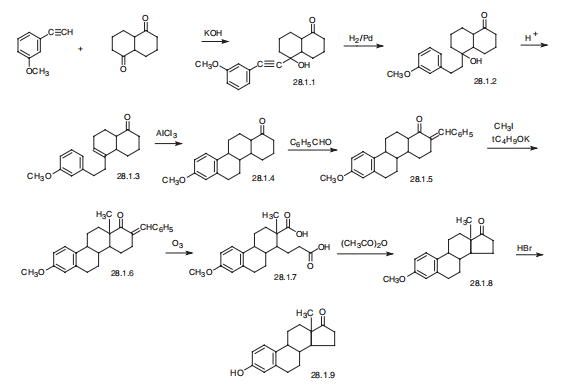
Potential Exposure
Synthesized from ergosterol. Used in combination with progestogen as an oral contraceptive.
First aid
If this chemical gets into the eyes, remove anycontact lenses at once and irrigate immediately for at least15 min, occasionally lifting upper and lower lids. Seek medical attention immediately. If this chemical contacts theskin, remove contaminated clothing and wash immediatelywith soap and water. Seek medical attention immediately. Ifthis chemical has been inhaled, remove from exposure,begin rescue breathing (using universal precautions, including resuscitation mask) if breathing has stopped and CPR ifheart action has stopped. Transfer promptly to a medicalfacility. When this chemical has been swallowed, get medical attention. Give large quantities of water and inducevomiting. Do not make an unconscious person vomit.
Metabolism
Hepatic.
Storage
Color Code—Blue: Health Hazard/Poison: Storein a secure poison location. Prior to working with thischemical you should be trained on its proper handling andstorage. Store in tightly closed containers in a cool, well-ventilated area. A regulated, marked area should be established where this chemical is handled, used, or stored incompliance with OSHA Standard 1910.1045.
Shipping
UN3249 Medicine, solid, toxic, n.o.s., Hazard Class: 6.1; Labels: 6.1-Poisonous materials.
Purification Methods
Purify estrone by chromatography on silica gel, eluting with 2:1 hexane/EtOAc and recrystallising from EtOH or Et2O/EtOH. [Danishefsky & Cain J Am Chem Soc 98 4975 1976.] The acetate [901-93-9] crystallises from EtOH with m 125-127o. [Beilstein 8 III 1171.]
Incompatibilities
May react exothermically with reducing agents to generate flammable gaseous hydrogen. Incompatible with oxidizers (chlorates, nitrates, peroxides, permanganates, perchlorates, chlorine, bromine, fluorine, etc.); contact may cause fires or explosions. Keep away from alkaline materials, strong bases, strong acids, oxoacids, and epoxides.
Properties of Estrone
| Melting point: | 258-260 °C(lit.) |
| Boiling point: | 353.48°C (rough estimate) |
| alpha | 158 º (c=1, dioxane) |
| Density | 1.2360 |
| refractive index | 165 ° (C=1, Dioxane) |
| Flash point: | 9℃ |
| storage temp. | room temp |
| solubility | Chloroform (Slightly), Dioxane (Slightly), Ethanol (Slightly), Methanol (Slightl |
| pka | pKa 10.77±0.02(H2O)(Approximate) |
| form | Crystalline Powder or Crystals |
| color | White to almost white |
| Water Solubility | 0.03 g/L |
| Merck | 3708 |
| BRN | 1915077 |
| CAS DataBase Reference | 53-16-7(CAS DataBase Reference) |
| NIST Chemistry Reference | 3-Hydroxyestra-1,3,5(10)-trien-17-one(53-16-7) |
| EPA Substance Registry System | Estrone (53-16-7) |
Safety information for Estrone
| Signal word | Danger |
| Pictogram(s) |
 Health Hazard GHS08 |
| GHS Hazard Statements |
H351:Carcinogenicity H362:Reproductive toxicity, effects on or via lactation |
| Precautionary Statement Codes |
P202:Do not handle until all safety precautions have been read and understood. P260:Do not breathe dust/fume/gas/mist/vapours/spray. P263:Avoid contact during pregnancy/while nursing. P264:Wash hands thoroughly after handling. P264:Wash skin thouroughly after handling. P270:Do not eat, drink or smoke when using this product. P308+P313:IF exposed or concerned: Get medical advice/attention. |
Computed Descriptors for Estrone
| InChIKey | DNXHEGUUPJUMQT-CBZIJGRNSA-N |
Estrone manufacturer
New Products
Indole Methyl Resin tert-butyl 9-methoxy-3-azaspiro[5.5]undecane-3-carboxylate Boc-His(Boc)-OH 2-CTC Resin 4-Chloro-7-tosy1-7Hpyrrolo[2,3-d]pyrimidine 5,7-Dibromo-1H-indole 2,5-dichloro-N-hydroxy-4,6-dimethylpyridine-3-carboximidamide 2,2-Dimethoxy-7-azaspiro[3.5]nonane hydrochloride 4-chloromethyl-5-methyl-1,3-dioxol-2-one (DMDO-Cl) R-2-BENZYLOXY PROPIONIC ACID 1,1’-CARBONYLDIIMIDAZOLE 1,1’-CARBONYLDI (1,2-4 TRIAZOLE) N-METHYL INDAZOLE-3-CARBOXYLIC ACID 4-((2-hydroxyethyl)thio)benzoic acid 1-(TERT-BUTOXYCARBONYL)-2-PYRROLIDINONE Methyl 6-methylnicotinate 3-Pyridineacrylic acid tert-Butyl carbazate TETRAHYDRO-2H-PYRAN-3-OL 2-((4-morpholinophenylamino) (methylthio) methylene) malononitrile 3-(4-morpholinophenylamino)-5-amino-1H-pyrazole-4-carbonitrile 2,4-dihydroxybenzaldehyde 1,3-Diethyl-1,3-Diphenylurea Methyl 2-methylquinoline-6-carboxylateRelated products of tetrahydrofuran
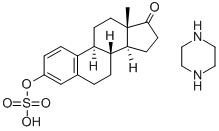




![1,3,5[10]-ESTRATRIEN-3-OL-17-ONE 3-GLUCURONIDE SODIUM SALT](https://img.chemicalbook.in/CAS/GIF/15087-01-1.gif)
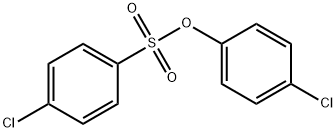

You may like
-
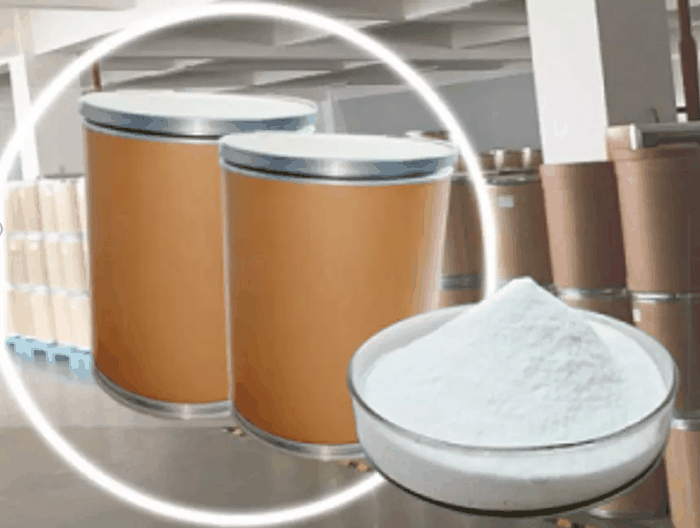 53-16-7 Estrone 98%View Details
53-16-7 Estrone 98%View Details
53-16-7 -
 Estrone 53-16-7 98%View Details
Estrone 53-16-7 98%View Details
53-16-7 -
 Estradiol EP Impurity A 53-16-7 96.56View Details
Estradiol EP Impurity A 53-16-7 96.56View Details
53-16-7 -
 53-16-7 Ethinylestradiol EP Impurity C/Estrone 95.02View Details
53-16-7 Ethinylestradiol EP Impurity C/Estrone 95.02View Details
53-16-7 -
 Estrone CAS 53-16-7View Details
Estrone CAS 53-16-7View Details
53-16-7 -
 Estrone CAS 53-16-7View Details
Estrone CAS 53-16-7View Details
53-16-7 -
 Estrone CAS 53-16-7View Details
Estrone CAS 53-16-7View Details
53-16-7 -
 Estradiol EP Impurity AView Details
Estradiol EP Impurity AView Details
53-16-7
